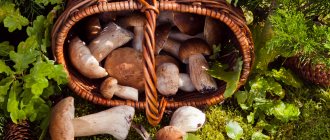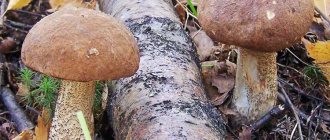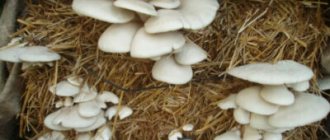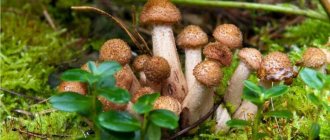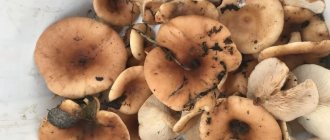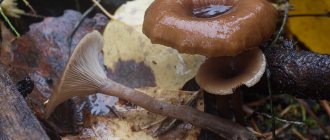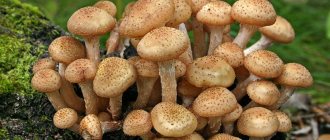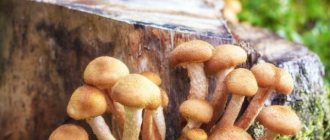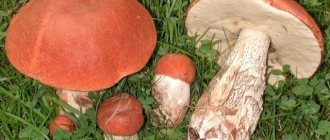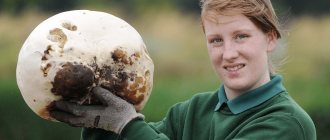Chuvashia is a place where forests are of particular value, the treasure of the republic, distinguished by the richness and diversity of plants and animals; Edible mushrooms are also hidden here, which are collected by both procurement organizations and amateurs. But so that “silent hunting” does not pose a danger to human health, but only brings benefit and pleasure, you need to know about the varieties of mushrooms in Chuvashia: which ones you can collect, and which ones you shouldn’t even approach. Let's look at what species grow in the region, where to find “secret” mushroom spots, and what exactly is collected at different times of the year.
Mushrooms of Chuvashia
One of the forest finds of Chuvashia is mushrooms, since this region is rightfully considered one of the most mushroom places in Russia due to favorable climate and soil conditions. Their mushroom picking was, is and will be one of the favorite pastimes of residents and guests of the region. Before you go on a “silent hunt,” you first need to remember where you should not or are prohibited from picking mushrooms:
- In Chuvashia, there are nature reserves and sanctuaries where collection is prohibited and punishable by a fine, but do not be upset, because there are many areas for legal collection of mushrooms - they will be discussed further.
- There is no need to collect fruits growing along roads or highways, as well as near industrial factories and landfills, as they accumulate substances harmful to health, which even heat treatment will not help get rid of. For example, the redhead mushroom absorbs harmful substances, so it is important to monitor the color of the cut of its stem - if over time it turns pink, it means the mushroom is unfit for food.
Before, armed with a compass and a basket, you go on a mushroom hunting trip, you should find out their varieties and learn to distinguish one from another. Often, mistakes in determining the type of find are made by both beginners and amateurs, as well as avid “pros” of quiet hunting, so it is extremely important to definitely study the mushroom component of Chuvashia.
Flag of Chuvashia.
Application
Despite its unprepossessing appearance, the gray row has a fairly high taste. The described mushroom is suitable for a variety of types of processing. It can be frozen, pickled, pickled, boiled, fried and dried. When preparing dishes, you can use both young and very mature mushrooms.
Before cooking mushrooms, it is recommended to thoroughly clean and rinse them to remove any remaining leaves and soil, and remove the skin from the caps. After boiling, the pulp of the gray row changes its color to gray-white with a faint chestnut tint.
Edible
In Chuvashia, along with the onset of warm weather, many edible species appear, which makes it possible to return home with a full basket and stock up on fresh fruits for the winter. They are nutritious and rich in proteins, fats, carbohydrates and vitamins. Such mushrooms differ from harmful inedible ones in shape, structure, color and even smell. Some edibles are even called medicinal because they have beneficial effects on health, such as helping to reduce high blood pressure.
Expert opinion
Melnikov Vladimir Mikhailovich
Knows 1000 ways to cook, pickle and marinate any types of mushrooms
Mushrooms suitable for consumption are classified in different ways: according to the area where they grow, structure, etc., but it is not necessary to know all the classifications, it is only important to remember the description of the fruit. On the territory of Chuvashia you can find more than 200 species of mushrooms suitable for consumption - let’s get acquainted with the common ones.
The following 4 types of mushrooms grow almost throughout the entire territory of the republic.
BOROTOVIKOV
An edible and at the same time tasty mushroom, the cap has a brown color, a loose stem with black scales along the entire length, and a pleasant, mild odor. It begins to grow especially intensively after rains, as it loves moisture.
1-Boletus turning pink. 2-Grey boletus.
ASPENS
Like boletus, it belongs to the genus of mushrooms of the Boletaceae family, however, unlike it, it has a dense thick stalk with black scales. They are most delicious when they are young: at this age they have a ball-shaped cap, which after a while begins to resemble a plate in shape.
1- Boletus yellow-brown. 2- White boletus.
HELLO
They grow in large numbers in the forests of Chuvashia, usually “live” on stumps and decaying trees, mainly in the form of a ring-bracelet. They do not have a specific cap color - it varies from cream to reddish. They are distinguished by a long stem and a slightly downward-curved cap, dotted with small scales on the surface, the smell is pleasant, and the taste is sour.
1-Summer honey agaric. 2-Wood honey fungus. 3-Autumn honey fungus.
Russula
They have a beautiful bright color, a convex cap with matte skin and a faint odor, and are very common in Chuvashia. It can germinate either singly or in groups.
1-Russula is violet-green. 2- Russula is pungent.
In addition to the listed species, there are others in Chuvashia that are not so widespread, but no less tasty.
BREASTS
They grow in mixed birch and pine forests. The cap is white with a small depression, the skin is olive-colored, and becomes sticky when wet; the leg tapers downward, and the color is almost the same as the cap. Black milk mushrooms are common on the territory of Chuvashia, but white ones, according to the mushroom map, can only be found in the Volga region.
1- The diaper is white. 2 – The breast is white. 3 – Pepper breast.
OILY
They have a small, sometimes flat, brown or orange cap; the leg is yellowish or white, as is the juicy flesh. They usually germinate near young pines.
Butter
CHANTERELLES
Distinctive features are their yellow color and their fruiting body, which does not have a clear boundary between the cap and the stem; moreover, one does not differ in color from the other, and the skin of such mushrooms is dense and fleshy. Chanterelles grow in Chuvashia close to clusters of pines, oaks and spruces, sometimes in rows or “witch circles”.
1-The fox is real. 2-False red fox.
WHITE MUSHROOMS
It has a spicy taste and aroma, a brown cap and tightly connected skin with pulp, like chanterelles. As a rule, they germinate everywhere. It is important to know that there is its unusable double - false or gall porcini mushroom.
1-Gyroporus is blue. 2-Porcini mushroom.
General information about rows
Before we move on to the description and photo of the sulfur row, we will present general information about all the row mushrooms. Several externally similar genera of the Ryadovaceae family have this name in Rus'. But some mushrooms of other genera of the same family can be called in the same way.
To a greater extent, these are fungi of the genus Tricholoma. For example, purple, lilac-footed and violet belong to the genus Lepista, and the May row belongs to the genus Calocybe. Moreover, these mushrooms can be classified as different genera only by microbiological characteristics, but according to external data, they are almost all similar - the same shape, they grow in rows, the same smell. Mycological scientists themselves cannot make up their minds, which is why many of the species wander among different genera. Their main characteristic is that they grow in groups (rows).
You can get acquainted with one of the types of mushrooms - the sulfur row (photos and descriptions are presented in the article) by reading the material presented below. It is very important for mushroom pickers to know that among them, unfortunately, there are also poisonous ones, although not fatal. The worst that can happen is long-term intestinal upset. Unfortunately, although these mushrooms are common, they are difficult to identify.
This genus received its name for its characteristic growth pattern - in groups (in a row or in rings).
Ryadovki is a numerous genus of mushrooms, in which there are more than 2.5 thousand species. For mushroom pickers, only a few species are of particular interest - about 5, of which only 3 species are classified as edible and 2 as conditionally edible.
Poisonous
Even once edible mushrooms are poisonous if they become old and wormy. You can build a list of the most common poisonous species in Chuvashia. Each of them contains a toxic substance that is harmful to the human body, including death:
DEATH CAP
This mushroom is especially insidious and is found in almost all forests of Chuvashia. It also received the name “green fly agaric.” Has a thin long stem and an ovoid cap when young; greenish-white color.
Death cap.
MOUNTAIN (PLUSH) WEB
Found in various forests near oak trees; It has a bright orange or brownish color of a small cap and seventeen types of deadly toxic substances in its composition.
Mountain gossamer.
THIN PIG
Svinushka is identified by its short leg and olive-brown cap; it can be found in all regions of Chuvashia. Consumption of this type of poisonous mushroom can lead to severe kidney failure and subsequent death.
Thin pig
FIBER CURLED
A deadly poisonous mushroom that lives in coniferous and, less commonly, mixed forests. The brown or dark brown color of the cap and stem can help identify this mushroom. The composition, like that of the thin pig, contains the poison muscarine.
The fiber is similar.
GIANT STITCH AND ORDINARY STITCH
The giant one grows in rare birch forests or next to middle-aged birch trees, while the ordinary one grows in pine and mixed forests. They grow simultaneously during the period of late April-early June, outwardly they look like crumpled paper.
The line is gigantic.
ENTOLOMA POISONOS
Closing the list of toxic mushrooms is the poisonous entoloma, which lives in deciduous forests. The color of its cap varies from white to light brown. Not fatal, but can lead to stomach problems.
Entoloma is poisonous.
Butter
Butterflies grow in coniferous forests. They got their name from the cap, which in rainy weather becomes sticky and shiny, as if it had been oiled.
They appear after the first summer rain. The disadvantages of this variety include a short period of existence and rapid eating by worms.
Appearance
Usually boletus is small to medium in size and resembles flywheels in appearance. They have a hemispherical or conical cap. With age, it straightens and looks more like a pillow. Its maximum diameter is 15 cm. The top of the cap is covered with skin that can be easily removed in young specimens.
They have a tubular hymenophore of light yellow color. The flesh is white, the cut turns blue or red. Butternuts age quickly and after 7-8 days they become tough and the flesh darkens. Description of the leg:
- diameter – 1-3 cm;
- height – 5-10 cm;
- the bottom is white or matches the color of the hat;
- the surface is rough to the touch.
Poisonous analogues
Some edible types of boletus are similar to the pepper mushroom. But it is smaller in size, the diameter of the cap is 4-5 cm, the height of the stem is 4-6 cm. The peppercorn has a light brown tint, the flesh is yellow. It has a sharp, burning taste and is considered inedible precisely because of this.
Irina Selyutina (Biologist):
Despite the fame of the inedibility of pepper butterdish, some mushroom pickers believe that it is possible to eat it as butterdish. They believe that spicy lovers will enjoy it either as a complete single dish or in “company” with other mushrooms, where it will successfully replace black pepper, usually added during frying.
Based on the substances contained in it, the pharmaceutical industry produces a number of vital drugs, in particular those capable of stabilizing blood pressure and activating brain function.
It forms mycorrhiza with pine, therefore it prefers coniferous forests with a predominance of this tree species. Less often it can be found in mixed, deciduous or spruce forests. The collection begins in June.
Time and place of fruiting
The first boletus is collected in June, but sometimes they are found even in May. They grow in pine forests (prefer young plantings), but some species bear fruit next to birch and oak trees.
They do not like dark areas of the forest, so they are found in small clearings, forest edges and in thickets of young pine needles. Butterflies can grow in clusters (very often they form entire snake ribbons) and individually.
Mushroom places
Finding mushrooms can be made easier by knowing where they grow in greatest abundance. Therefore, before going on a “silent hunt”, it is advisable to know in advance the places where they are most concentrated. There are so many mushroom places in the region that a mushroom picker will definitely not return home without them.
The south of Chuvashia - the Alatyr region - is favorable for the growth of a large number of boletus (usually found on the edges and along paths), milk mushrooms, boletus with boletus and boletus. A treasure in the form of mushroom diversity can be found in the forests of Mariinsky Posad - here, on the banks of the Volga, black milk mushrooms, chanterelles and much more grow.
In the Shemurshinsky region of Chuvashia, a mushroom picker will come across honey agarics, chanterelles, red mushrooms and more, and the Volga region is fraught with accumulations of milk mushrooms (both black and white), honey mushrooms, chanterelles, honey mushrooms, saffron milk caps and russula. Each type of mushroom has its own “favorite” place for germination. So, it is worth knowing, for example, that black milk mushrooms are most often found in the Volga region, Mariinsky Posad and near Ibresi.
The first signs of poisoning
The list of primary symptoms of poisoning includes:
- weakness;
- dizziness;
- gagging;
- stool disorder;
- increased gas formation;
- bloating;
- pain of varying intensity in the stomach, pancreas, liver and intestines;
- pain;
- convulsions;
- hallucinations;
- fainting conditions;
- heat.
Mushrooms in the Tver region in 2022 are found in huge quantities not only in forest areas, but also near rivers, fields and even parks. They can only be collected in clean areas with good ecology.
What is collected in spring, summer and autumn
The mushroom season in Chuvashia lasts for several months, and during this time you can manage to collect more than one basket of fruits. Mushroom picking in Chuvashia often starts at the end of summer, but for some species you can go to the forest earlier, in the second half of spring. Due to the abundance of precipitation in autumn, the mushroom season lasts until October. The table shows a list of mushrooms that are most often purchased in Chuvashia at different times of the year.
| Month. | Types of mushrooms. |
| March | Oyster mushrooms |
| April | Oyster mushrooms, morels |
| May | Russula, boletus, boletus |
| June | Porcini mushrooms, boletus |
| July | Porcini mushrooms, boletus, chanterelles |
| August | Porcini mushrooms, chanterelles, saffron milk caps, boletuses, boletuses, hemp mushrooms, winter mushrooms |
| September | Hemp mushrooms, winter mushrooms, chanterelles, boletus |
| October | Chanterelles, boletus |
Collection recommendations
- Tip #1
Tver is a city far from the list of regions with a clean environment. Therefore, doctors strictly prohibit picking mushrooms near roads, highways and polluted areas, located near processing plants and places with polluted air.
- Tip #2
It is better to go for mushrooms in the first half of the day, when mushroom pickers have not yet had time to comb the forest, leaving only roots.
- Tip #3
Before picking mushrooms, you should arm yourself with such items as: a navigator to plot a route to the right place, a GPS to leave a point on the map, not to lose your car and leave the forest, a knife, one or more baskets, a raincoat so as not to get your clothes and head wet.
Beneficial features
Pushers are nutritious. They have special biologically active components called betaines. Betaines are beneficial for humans because they affect the metabolic process in the body. The composition is similar to that characteristic of float and porcini mushroom.
Pusher contains many vitamins, especially group B, and other microelements, as do other edible types of fly agarics.
Pushers are nutritious and healthy

